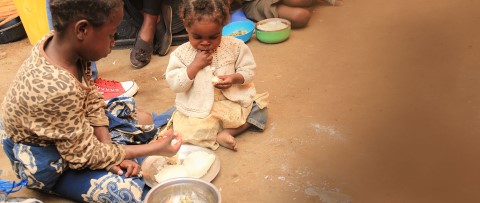- Thought Leadership


The Children International staff at her community center in Barranquilla, Colombia, quickly pinpointed the problem. Yarisol’s grandmother, Simona, was stunned to learn that Yarisol was underweight and required immediate intervention.
“I did not know that she was malnourished until the staff told me,” Simona recalls. “I felt very afraid because they told me about all the risks that a child could experience for being underweight.”
Simona had reason to be concerned. Seriously malnourished children may never achieve a normal height and weight and their brains may never develop to full cognitive potential, drastically limiting their future opportunities. Early intervention — while a child is only moderately malnourished, like Yarisol — is key to stopping the cycle.
When children like Yarisol become malnourished, it often doesn’t result from a lack of food; it can develop from a lack of healthy food. Poor families usually buy their food from street vendors rather than grocery stores, so they have access to fewer nutritious options. In addition, cheap, empty-calorie snacks are plentiful on street corners in impoverished communities and offer a quick fix for hunger — but don’t address a child’s core nutritional needs.
Parents often prioritize the short-term necessity of filling their children’s bellies without understanding the long-term effects of poor nutrition. The “right” foods are not always easy to find, because disadvantaged neighborhoods, particularly urban ones, often suffer from food insecurity — a lack of places to buy healthy, affordable foods. Families working long hours outside the home resort to convenient sugary, salty processed foods because they don’t have time to prepare meals. Over time, children become malnourished because their bodies aren’t receiving the essential nutrients they need to develop properly.

Yarisol and her grandmother, Simona, shop for healthy foods at their local market in Barranquilla, Colombia.
Yarisol was promptly enrolled in Children International’s nutrition rehabilitation program, which targets children up to age 12 who are moderately or severely undernourished. The program, which enables rapid improvements in health and nutritional status, enrolls children for a minimum of two months or until they have regained a normal weight.
Staff determine a child’s nutritional status using the Body Mass Index (BMI), a value derived from the ratio of weight to height. When a child is underweight, they are referred to the nutrition rehabilitation program, where they are monitored up to four times a year until they achieve a higher BMI.
Once identified, malnourished children take part in feeding sessions where they receive meals or nutritional supplements to help build up their weight. These sessions typically take place in Children International community centers, which usually have dedicated kitchens and dining areas for this purpose. The food provided varies based on the children’s needs and the most plentiful food sources in the area.

Osteen, 11, participates in the malnutrition rehabilitation program in Lusaka, Zambia.
In Colombia, children are given nutrient-rich drinks. In Zambia, the children receive meals made with kapenta, a widely available fish, prepared along with soybeans and nshima, a type of cornmeal that is the country’s staple food.
Our staff in Bicol, Philippines, coordinate with local schools to provide food. The meals focus on using fresh vegetables enhanced with malunggay, also known as moringa, a local plant rich in nutrients and vitamins.
In India, a pilot program is testing the use of ready-to-use therapeutic foods (RUTF), which the World Health Organization (WHO) says, “has revolutionized the treatment of severe malnutrition.” The portability and ease of preparation of Nutramix, a wheat-based powder, make it a better choice for children who live further from the community center.
Like most malnourished sponsored children, Yarisol’s condition was discovered at a regular medical checkup, where all children are evaluated for signs of malnourishment and other illnesses that can stem from being underweight.
Your support continues to help children and families around the world get the tools they need to live healthier lives and create brighter futures.
In part two, coming in December, learn how nutrition education teaches families how to make smarter choices with lasting benefits. And, see how Yarisol is doing today.
Helping families understand the essentials of good nutrition
When teaching nutrition education sessions, our trained staff often use mnemonic devices to make it easier for families to remember the basics of a healthy diet.
Katherine, a 10-year-old program participant in Bicol, Philippines, shares one of these techniques. “An important thing I’ve learned is eating “go, grow and glow foods,” she says. “These are the healthiest foods for me.”

Comments
Paula_c910f
Jan 7, 2020
As a school food service director for 35 years, I can certainly relate to the importance of good nutrition for school age children.
You must be logged in to comment. If you have an account, click here to log in.